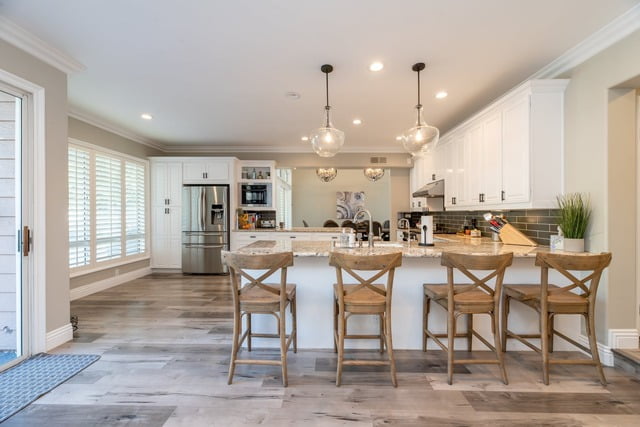Should I take out a loan for home improvements? Making the decision to invest in your home can be both exciting and daunting. From essential repairs to cosmetic upgrades, maintaining and improving your property’s value is a crucial aspect of homeownership. In this article, we will explore the reasons why people consider taking out a loan for home improvements and provide valuable insights into whether it is a wise financial decision.
As a homeowner, it’s important to recognize that regular maintenance and periodic upgrades are necessary to preserve your property’s value and enhance its livability. Whether it’s fixing the roof, updating the kitchen, or adding extra space, home improvements can have a significant impact on the comfort and functionality of your living space. However, these projects often come with a substantial price tag, leading many homeowners to consider borrowing money to fund their renovations.
In this article, we will delve into the factors to consider when weighing the costs and benefits of various home improvement projects. Additionally, we will discuss different loan options available for financing these endeavors and provide insights into alternative methods of funding to help you make an informed decision about your home improvement needs.
Calculating the Cost of Home Improvements
When considering home improvements, it’s crucial to understand the potential costs involved. Whether it’s a minor renovation or a major remodeling project, expenses can quickly add up. Planning and budgeting for these costs is essential to avoid financial strain in the long run.
The first step in calculating the cost of home improvements is to identify the specific areas that need attention. Whether it’s upgrading the kitchen, remodeling a bathroom, or adding a new deck, each project comes with its own set of expenses. According to HomeAdvisor, the national average for kitchen remodels is around $25,000, while bathroom remodels can cost between $10,000 and $15,000 on average.
In addition to material and labor costs, homeowners should also factor in any permits or inspection fees that may be required for certain projects. It’s important to account for unexpected expenses as well, as home improvement projects often come with unforeseen issues that may increase the overall cost.
| Home Improvement Project | Average Cost |
|---|---|
| Kitchen Remodel | $25,000 |
| Bathroom Remodel | $10,000 – $15,000 |
| Deck Addition | $7,500 – $10,000 (for a 200-500 square foot deck) |
Exploring Loan Options for Home Improvements
When considering home improvements, many homeowners find themselves asking the question: “Should I take out a loan for home improvements?” The answer to this question often depends on individual circumstances and financial considerations. In exploring the various loan options available for funding home improvement projects, it is important to weigh the benefits and risks of each option.
Comparing Different Types of Loans
There are several types of loans that homeowners can consider when financing home improvements. Home equity loans, for example, allow homeowners to borrow against the equity in their property, while personal loans offer a more flexible borrowing option. Government-backed loans, such as FHA Title I Property Improvement Loans, may also be available for qualified borrowers. Each type of loan has its own set of requirements, interest rates, and repayment terms.
Pros and Cons of Each Loan Option
Before deciding on a specific type of loan for home improvements, it is essential to consider the pros and cons of each option. Home equity loans typically offer lower interest rates due to the collateral provided by the home, but they may come with higher closing costs and potential risk of losing the property if payments are not made.
Personal loans offer more flexibility in terms of use but may have higher interest rates. Government-backed loans may have specific eligibility criteria but can provide access to favorable terms and rates.
Considerations When Exploring Loan Options
When exploring loan options for home improvements, it is important for homeowners to assess their current financial situation and long-term goals. Understanding one’s ability to make consistent payments on a loan without straining finances should be a priority when considering taking out a loan for home improvements. Additionally, borrowers should factor in potential changes in income or expenses that could impact their ability to meet repayment obligations in the future.
As individuals explore different loan options for financing home improvements, it is crucial to compare the terms and conditions offered by lenders carefully. Considering factors such as interest rates, fees, repayment terms, and overall financial impact should be a priority before making any commitments related to borrowing money for home renovations.
Assessing the Financial Impact
When considering whether to take out a loan for home improvements, it is crucial to assess the financial impact of this decision. Home improvement projects can be costly, and taking out a loan can significantly affect your financial situation. Here are some important factors to consider when assessing the financial impact of borrowing money for home improvements.
Cost of the Project
First and foremost, it’s essential to calculate the total cost of the home improvement project you have in mind. This includes not only materials and labor but also any unexpected expenses that may arise during the project. Having a clear understanding of how much you need to borrow will help you make an informed decision about whether taking out a loan is necessary.
Return on Investment
Another crucial aspect to consider is the potential return on investment (ROI) for the home improvement project. Some projects, such as kitchen or bathroom remodels, have a high ROI and can significantly increase the value of your home. On the other hand, other projects may not yield as much return. Evaluating the potential ROI will help you determine whether it makes financial sense to take out a loan for a particular home improvement.
Repayment Terms
Before deciding to take out a loan for home improvements, carefully review the repayment terms offered by different lenders. Consider factors such as interest rates, monthly payments, and total repayment amount over time.
It’s important to ensure that you can comfortably afford the additional financial burden that comes with taking out a loan. Assessing the long-term impact on your budget and overall financial stability should i take out a loan for home improvements requires careful consideration of these key factors before making your decision.
Understanding the Risks of Taking Out a Loan
When considering whether to take out a loan for home improvements, it’s important to understand the potential risks involved. While getting a loan can provide the funds needed to make necessary upgrades to your home, it also comes with certain drawbacks that should be carefully considered. Here are some key risks to keep in mind when contemplating whether you should take out a loan for home improvements:
- Interest payments: One of the primary risks of taking out a loan for home improvements is the additional cost of interest payments. Depending on the type of loan and its terms, you could end up paying a significant amount in interest over the life of the loan.
- Debt burden: Taking on additional debt through a home improvement loan can potentially strain your finances, especially if you already have other outstanding debts. It’s important to assess whether you can comfortably manage the monthly payments without sacrificing other essential expenses.
- Financial overextension: Another risk to consider is the potential for overextending yourself financially. If unexpected expenses or financial hardships arise, having an additional loan payment could create added stress and strain on your budget.
It’s crucial to weigh these potential risks against the benefits of financing your home improvements with a loan. While securing funding can allow you to enhance your living space and increase the value of your property, it’s essential to proceed with caution and fully understand the long-term implications.
Ultimately, whether or not you should take out a loan for home improvements depends on your individual financial situation and goals for your home. Considering the potential risks and being mindful of how taking on additional debt could impact your overall financial well-being is crucial in making an informed decision about how to finance your home improvement projects.
Alternative Ways to Finance Home Improvements
When considering home improvements, many individuals wonder, “should I take out a loan for home improvements?” While loans can be a viable option for financing these projects, there are also alternative ways to fund home renovations that should be carefully considered. One such alternative is to save money specifically for home improvements.
Creating a dedicated savings fund allows you to avoid taking on additional debt and the associated interest payments. Additionally, using cash from savings provides the added benefit of not having to go through a loan approval process.
Another alternative method to finance home improvements is by using a credit card. For smaller scale projects with manageable costs, using a credit card with low-interest rates or promotional offers can be an effective way to cover expenses. However, it’s important to weigh the benefits against potential drawbacks such as high interest rates and the risk of accruing significant credit card debt if not managed responsibly.
Tapping into home equity is yet another alternative method for financing home improvements. This involves borrowing against the equity in your property through options like home equity lines of credit (HELOC) or cash-out refinancing.
Home equity loans often offer lower interest rates compared to personal loans or credit cards, making them an attractive option for substantial renovation projects. However, it’s crucial to consider the risk of potentially losing your home if you are unable to meet the repayment terms.
| Alternative Financing Method | Advantages | Disadvantages |
|---|---|---|
| Saving Money | Avoids additional debt and interest payments | May take longer to accumulate sufficient funds |
| Using a Credit Card | Can take advantage of low-interest rates or promotional offers | Risk of high-interest rates and potential credit card debt accumulation |
| Tapping into Home Equity | Lower interest rates compared to other loan options | Risk of losing your home if unable to meet repayment terms |
These alternative methods provide individuals with options beyond traditional loans when it comes time for making necessary upgrades and renovations in their homes.
Tips for Making Smart Decisions
When considering whether to take out a loan for home improvements, it’s important to make informed and responsible decisions. Here are some practical tips to help you navigate this important financial decision:
- Research Loan Options: Take the time to thoroughly research different loan options available for home improvements. Compare and contrast home equity loans, personal loans, and government-backed loans to determine which option best fits your needs and financial situation.
- Consider Interest Rates and Repayment Terms: When evaluating loan options, pay close attention to the interest rates and repayment terms. A lower interest rate can save you money in the long run, while favorable repayment terms can make managing the loan more manageable.
- Assess Future Financial Strain: Before taking out a loan for home improvements, carefully consider the potential impact on your future financial situation. Determine whether adding monthly loan payments will strain your budget or hinder your ability to meet other financial obligations.
Conclusion
In conclusion, the decision to take out a loan for home improvements is a significant one that should not be taken lightly. While maintaining and improving the value of a home is important, it is crucial to carefully consider all options before committing to borrowing money. Calculating the cost of home improvements and exploring loan options are essential steps in making an informed decision.
When considering whether or not to take out a loan for home improvements, it is important to assess the financial impact and potential return on investment. Homeowners should weigh the costs of borrowing against the long-term benefits of the improvements. Additionally, understanding the risks of taking out a loan is crucial, as it can have a lasting impact on one’s financial well-being.
While taking out a loan for home improvements may be a viable option for some, there are also alternative ways to finance such projects. Saving up, using a credit card with low interest rates, or tapping into existing home equity are all possible avenues that homeowners should consider before deciding on taking out a loan. Ultimately, making smart decisions about financing home improvements requires careful consideration of all available options and their implications.
Frequently Asked Questions
What Are the Pros and Cons of Home Renovation Loans?
Home renovation loans can be advantageous because they provide funds for improving one’s home without having to pay for everything upfront. This can make renovations more accessible for homeowners. However, the downside is that there may be high interest rates and fees associated with these loans, which can end up costing more in the long run.
Is It Better to Pay Cash or Finance Home Improvements?
Whether it’s better to pay cash or finance home improvements depends on individual circumstances. Paying cash can save money on interest and financing fees, but it may deplete savings or emergency funds. Financing allows for spreading out payments over time, making larger projects more manageable, but it can also mean paying more in interest.
Why Are Home Improvement Loans So Expensive?
Home improvement loans can be expensive due to a few factors. First, these loans are often unsecured or have shorter terms, which poses a higher risk to lenders. This risk is often reflected in higher interest rates for borrowers. Additionally, the costs of administering and overseeing these types of loans can contribute to their overall expense for borrowers.

I’m thrilled to have you here as a part of the Remodeling Top community. This is where my journey as an architect and remodeling enthusiast intersects with your passion for transforming houses into dream homes.





